34 Compact Living Room Ideas 2026: Modern Small-Space Designs for Tiny Apartments and Studios
Designing a compact living room in 2026 raises an important question: how do we turn increasingly small houses, tiny apartments, and even micro studio layouts into spaces that feel comfortable, stylish, and functional? With rising urban density in cities like Mumbai and across India, modern households are rethinking traditional layout strategies. But what truly makes a small space efficient and visually harmonious? In this article, I will explore practical concepts, furniture solutions, and layout ideas that I personally use when planning compact interiors.
As I guide you through each section, I will break down modern approaches to space optimization, explain why certain furniture is worth incorporating, and share my own observations from years of working with tight floor plans. Whether you live in a modern apartment, a small urban flat, or a minimalist home, these strategies will help you transform limited square footage into an inviting living environment. Let’s dive into the smartest Compact Living Room Ideas 2026 and see how to elevate even the smallest layouts with style and intention.
Compact Living Room: Designing Smarter Small Spaces
When I design a compact living room, I focus on creating clear visual zones without overwhelming the layout. In 2026, clean lines, layered textures, and integrated technology are shaping how designers approach smaller homes. I usually emphasize neutral palettes and streamlined surfaces to make the space feel open. This approach ensures that even when a living room measures under 200 square feet, it still feels airy and functional. By incorporating space-saving solutions, I can easily blend aesthetic appeal with practicality.
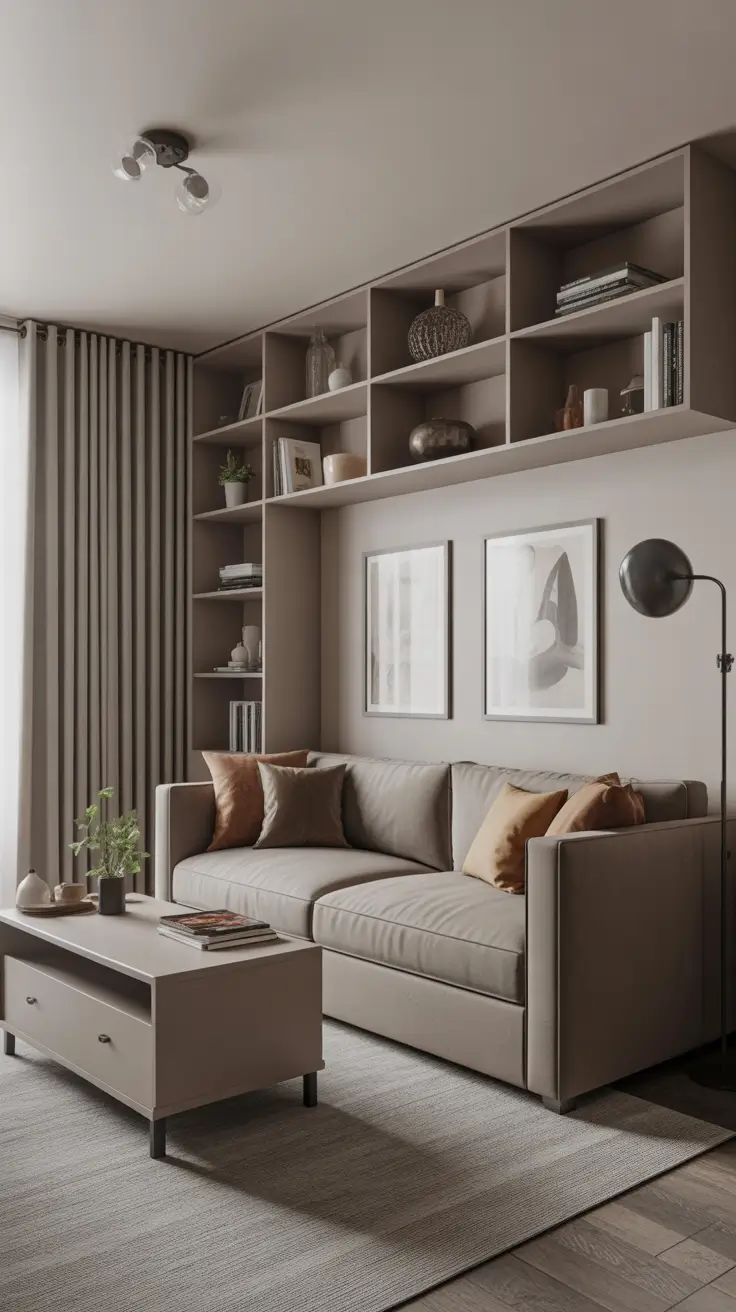
When selecting specific furniture, I always prioritize pieces that perform multiple roles. A slim-profile sofa with hidden storage, a lift-top coffee table, or modular shelves can substantially expand functionality. I also appreciate wall-mounted lighting, because eliminating floor lamps helps free up valuable square footage. Every element must earn its place, especially in tiny apartment and modern apartment layouts where each inch matters.
From my personal experience, small living rooms tend to succeed when homeowners embrace intentional simplicity instead of trying to fit in everything. Over the years, I’ve seen that people feel more comfortable and less visually overwhelmed when the room is curated rather than crowded. Professionals at Architectural Digest have also emphasized the importance of balancing negative space with essential furniture to create visual calm.
To further strengthen this section, I would add more emphasis on color psychology and how warm neutrals or cool undertones can influence the perceived size of the living room. This would help readers understand how subtle palette choices affect comfort in limited spaces.
Transforming Tiny Apartments Into Stylish Living Zones
When I work on a tiny apartment, I approach it as a complete puzzle where each area must seamlessly connect with the next. The living zone acts as the adaptable heart of the home, often serving as a social area, workspace, and relaxation corner. I typically rely on streamlined décor, creating a visual flow that minimizes clutter and enhances openness. This helps tenants feel as though they live in a much larger home.

Furniture selection is crucial. I opt for compact sofas with narrow arms, nesting tables that can be stored easily, and compact entertainment units that don’t protrude too far from the wall. These pieces help create a polished, proportional layout without sacrificing comfort. Smart wall shelving also makes a noticeable difference, keeping essentials within reach while leaving the floor unburdened.
From my experience, clients often underestimate the transformative power of proper lighting. Well-placed recessed lighting and sleek sconces can pull the eye upward, expanding the perceived height of the room. I have also seen great success incorporating mirrors opposite windows to amplify natural light and add depth.
To enhance this section further, I would include more examples of specific zoning techniques such as rug placement or sliding partitions. These additions would help readers visualize how to divide functions without building walls.
Clever Layouts For Tiny Studio Apartments
When designing a tiny studio, I always start by analyzing movement flow. The living room frequently blends with the sleeping and dining areas, so choosing the right layout becomes essential. I prefer L-shaped or floating sofa placement to create a soft boundary without dividing the room physically. This makes the studio feel intentional and cohesive rather than cramped.
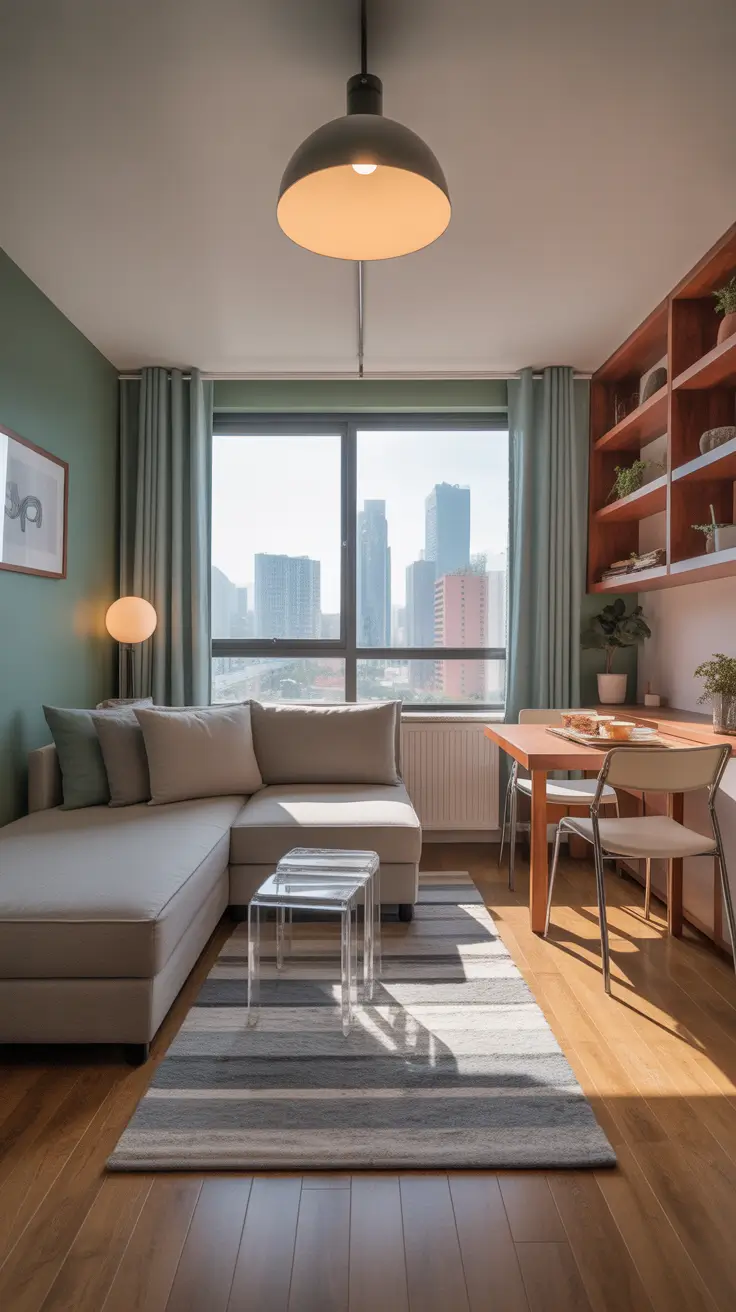
Furniture plays a decisive role here. I rely heavily on slim sofa beds, foldable dining sets, and compact sideboards that double as TV stands. These pieces allow residents to transition the room from daytime to nighttime use effortlessly. I also like transparent furniture elements, such as acrylic side tables, because they reduce visual weight while remaining fully functional.
I’ve observed that young professionals who live in studios benefit most from using vertical space effectively. Tall shelving units, wall-mounted desks, or overhead cabinets create extra storage without reducing floor area. This is a principle repeatedly recommended by interior design experts at House Beautiful, and I’ve seen firsthand how well it works in densely populated cities.
What I would add to this section is a brief explanation of sound zoning. In small studios, soft textiles such as rugs, acoustic panels, or fabric headboards can subtly separate living zones while improving acoustics.
Maximizing Every Inch In Micro Studio Apartments
Micro studios require some of the most inventive strategies, and I usually approach them with precision. Every choice must support comfort despite extremely limited space. I rely on hidden storage, fold-away furniture, and wall-integrated systems to keep the living area open. In such compact settings, I make sure that furniture lines stay sleek and minimal to maintain a sense of breathing room.

The furniture I select for micro studios usually includes wall-folding sofa sleepers, telescopic tables, and ultra-slim shelving. These are essential because they adapt to different daily needs without crowding the room. Multi-height storage, especially around door frames, is another favorite approach of mine, as it uses space that most homeowners forget about.
In my own design experience, micro studios offer great opportunities for creative thinking. Many residents initially worry that they cannot achieve comfort, yet with the right furniture and smart planning, these spaces quickly become warm and efficient. I often introduce soft lighting and flexible décor to avoid a boxed-in feeling.
To improve this section further, I would add a dedicated explanation of color contrast. Light-colored walls combined with darker, grounding furniture can anchor the room while maintaining visual openness.
Smart Solutions For Modern Small Houses
When I work with small houses, I focus on harmonizing the living room with the home’s overall architecture. In 2026, open layouts, modular walls, and eco-friendly materials define modern small-house living. I like integrating natural textures because they make compact rooms feel grounded yet airy. I keep the living room simple but efficient, maximizing storage through built-in cabinetry.
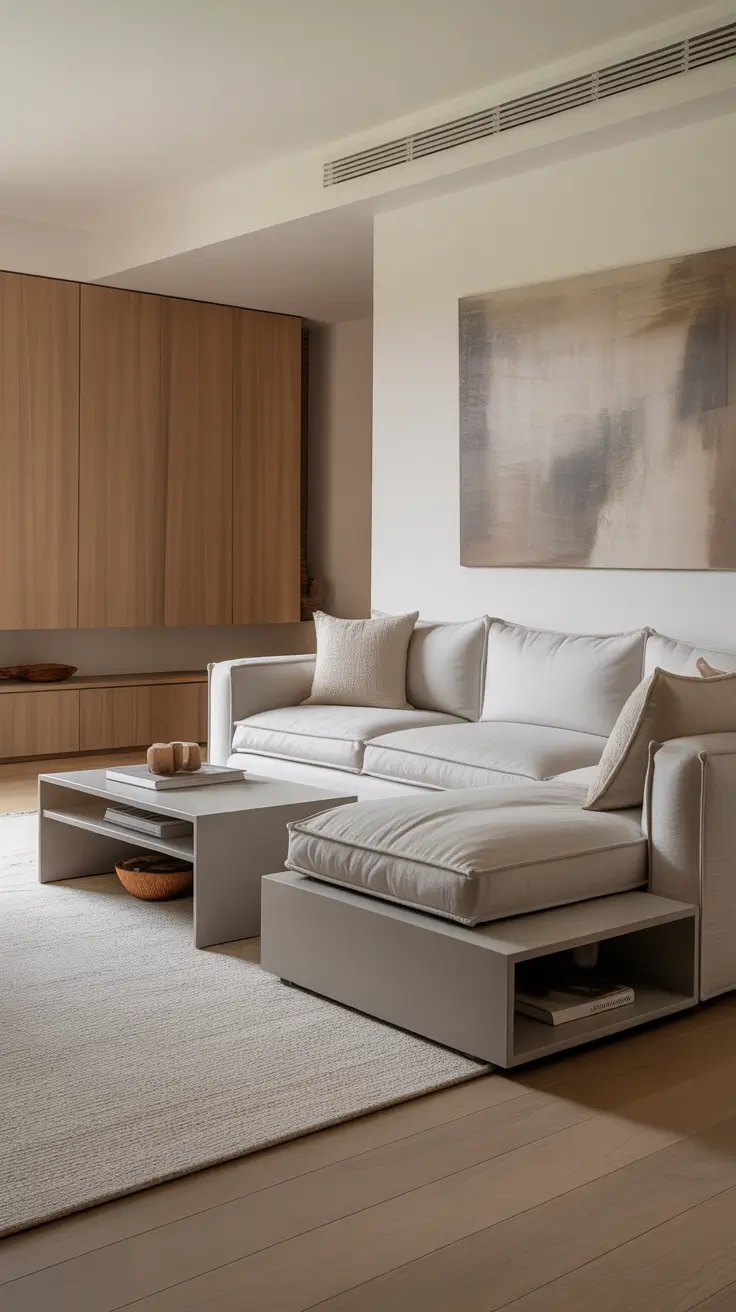
The furniture I choose includes sectional sofas with storage in the chaise, multifunctional coffee tables, and lean media consoles that align with the home’s structural lines. These items blend form and function while supporting a seamless, uncluttered flow. Large-format wall décor can also make the room appear more expansive without overwhelming the space.
In my experience, small houses thrive when homeowners commit to intentional minimalism. I frequently advise clients to invest in fewer but higher quality pieces that serve multiple roles. This aligns with recommendations from major design platforms like Dwell, which emphasize both function and longevity.
I would strengthen this section by adding advice about integrating indoor plants to soften corners and improve air quality. Plants, when placed strategically, bring life without adding clutter.
Mumbai-Inspired Compact Living Innovations
Working with Mumbai-inspired interiors means embracing ingenuity, cultural richness, and extreme space awareness. Homes in Mumbai often deal with very limited square footage, so I draw inspiration from multifunctional setups and locally sourced materials. I aim to incorporate warm neutrals, subtle traditional elements, and efficient built-ins that reflect modern India’s evolving taste.
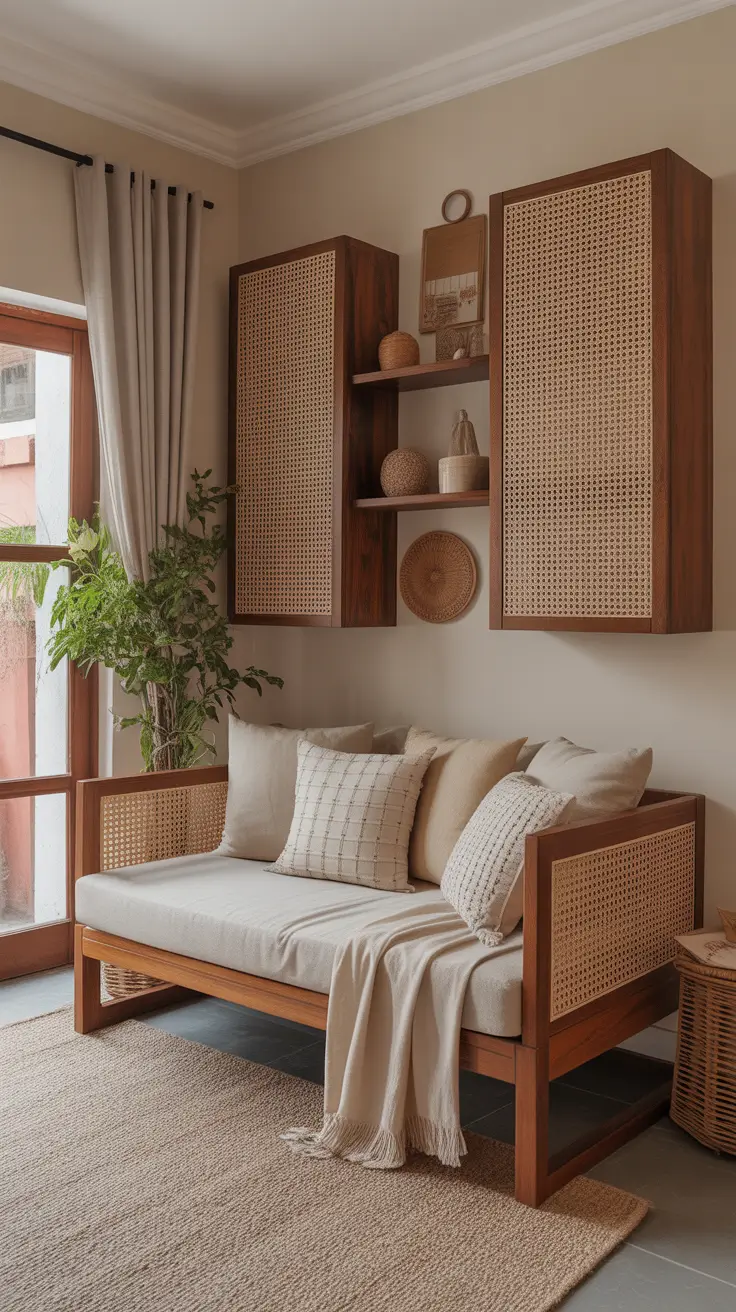
For furniture, I lean toward compact wooden sofas, bamboo or rattan accents, and modular benches that add storage. Wall-mounted units are essential in Mumbai-style compact living because they free the floor and create an organized layout. Lightweight textiles, especially cotton and linen, help maintain airflow and keep the living room visually light.
Through my work with clients who moved from Mumbai, I learned how valuable adaptability is. Most families appreciate transformable furniture and smart wall partitions that maintain flexibility. Local interior designers frequently emphasize the beauty of blending traditional craftsmanship with modern efficiencies, which I find incredibly inspiring.
To complete this section, I would add a note about integrating handcrafted décor to maintain authenticity. These touches provide warmth and personality that elevate compact homes.
Interior Design Trends Shaping India In 2026
In 2026, interior design trends in India highlight sustainability, modularity, and cultural modernism. When I design compact living rooms aligned with Indian trends, I balance fresh aesthetics with practicality. Light woods, contemporary artwork, and polished finishes often set the tone. I always explore ways to combine traditional motifs with sleek silhouettes to keep the space both current and rooted.
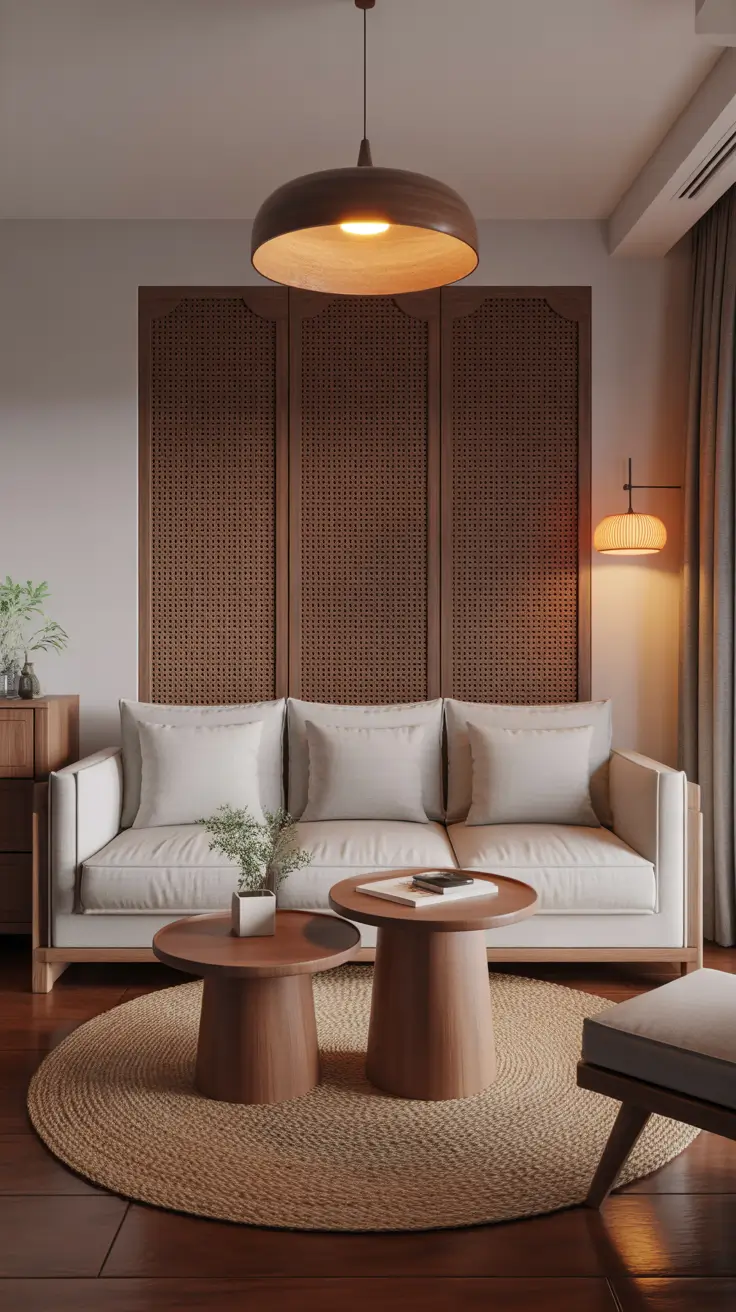
For furniture, I often choose modular sofas, nesting tables, wood-metal blends, and compact handcrafted pieces. These selections highlight the modern Indian aesthetic without overwhelming smaller living rooms. Natural textures such as jute rugs or cane panels help maintain cultural warmth while supporting minimalist design principles.
In my experience, Indian homeowners appreciate multifunctional designs that respect tradition while embracing global trends. Many follow advice from international interior experts who emphasize harmony between materials and space. This connection between old and new continues to shape compact homes in India.
To enhance this section further, I would incorporate a brief discussion on lighting temperature. Warm lighting supports Indian décor beautifully and enhances comfort in smaller rooms.
Space-Saving Sofas For Small Living Rooms
In compact living rooms, the sofa becomes the anchor of the entire layout, so I always approach its selection with extreme care. In 2026, space-saving sofas are designed to be sleek, modular, and multifunctional, which is ideal for tiny apartments, small houses, and urban living in places like Mumbai. I generally choose sofas with slim silhouettes, raised legs, and neutral upholstery to create a sense of openness. Incorporating light fabrics and subtle textures allows the room to feel soft yet spacious, while still supporting everyday comfort. This approach helps small living rooms maintain proper visual balance without appearing crowded.

The furniture pieces I rely on include modular L-shaped sofas with integrated storage, slim two-seaters, and pull-out sofa beds. These options maximize usability while keeping the floor plan clean. When possible, I also incorporate ottomans that double as both seating and storage, plus side tables that integrate directly into the sofa frame. These choices eliminate the need for extra standalone furniture, freeing valuable floor space and supporting seamless movement throughout the room. Wall-mounted lighting further enhances the area, creating a polished and uncluttered look.
Over the years, I’ve seen how dramatically a well-chosen sofa can transform smaller spaces. Many homeowners underestimate how crucial proportions are, but experts at Elle Decor consistently highlight the impact of selecting the right sofa depth and arm style. I’ve followed this guidance myself, observing how narrower arms and taller legs can visually elongate a room. When executed correctly, the living room feels lighter, more modern, and fully optimized.
To refine this section further, I would add examples of upholstery tones that work best in small spaces. Soft beige, muted charcoal, and warm gray fabrics help create harmony while still adding character. These tones enhance the sense of spaciousness and pair well with modern minimalist interiors.
Multifunctional Furniture That Enhances Apartment Living
In any modern apartment, especially those with compact layouts, multifunctional furniture is the key to creating a flexible, efficient living space. I typically begin by assessing the homeowner’s daily habits and adjusting the furniture strategy accordingly. I often incorporate transformable pieces that support work, relaxation, dining, and storage in one cohesive layout. This ensures that even a modest living room performs at its highest potential. By combining mobility with practicality, multifunctional furniture helps maintain freedom of movement while still offering exceptional convenience.

The pieces I usually select include lift-top coffee tables that convert into desks, adjustable side tables, modular shelving systems, and extendable TV consoles. I also rely on folding dining tables that can be tucked away when not in use, as well as compact benches that double as hidden storage units. These components work beautifully in tiny studio apartments, micro studios, or compact Indian homes, where every item must serve a purpose. Smooth finishes, rounded edges, and neutral tones integrate effortlessly into modern interiors.
From my experience, homeowners often feel empowered when their living room adapts to their needs rather than restricting them. Many interior design professionals, including those featured in Domino Magazine, emphasize the rising importance of transformable furniture in urban environments. I’ve witnessed firsthand how these innovations elevate everyday living by making small apartments feel dynamic and versatile. With the right pieces, the room becomes a multifunctional environment without sacrificing aesthetics or comfort.
To complete this section, I would add a deeper explanation of materials, especially recommending lightweight woods and metal frames for durability without adding visual heaviness. This ensures the furniture remains practical and proportionate in a smaller apartment.
Minimalist Styling For Clean And Calm Interiors
Minimalist styling is one of the most effective approaches for compact living spaces, especially as we move into 2026. I typically rely on clean lines, uncluttered surfaces, and limited color palettes to create visual calm. This is particularly useful in urban India, where apartments often combine modern functionality with traditional influences. The minimalist style brings clarity to small spaces, enhancing light distribution and establishing a serene environment that feels more spacious than it is.
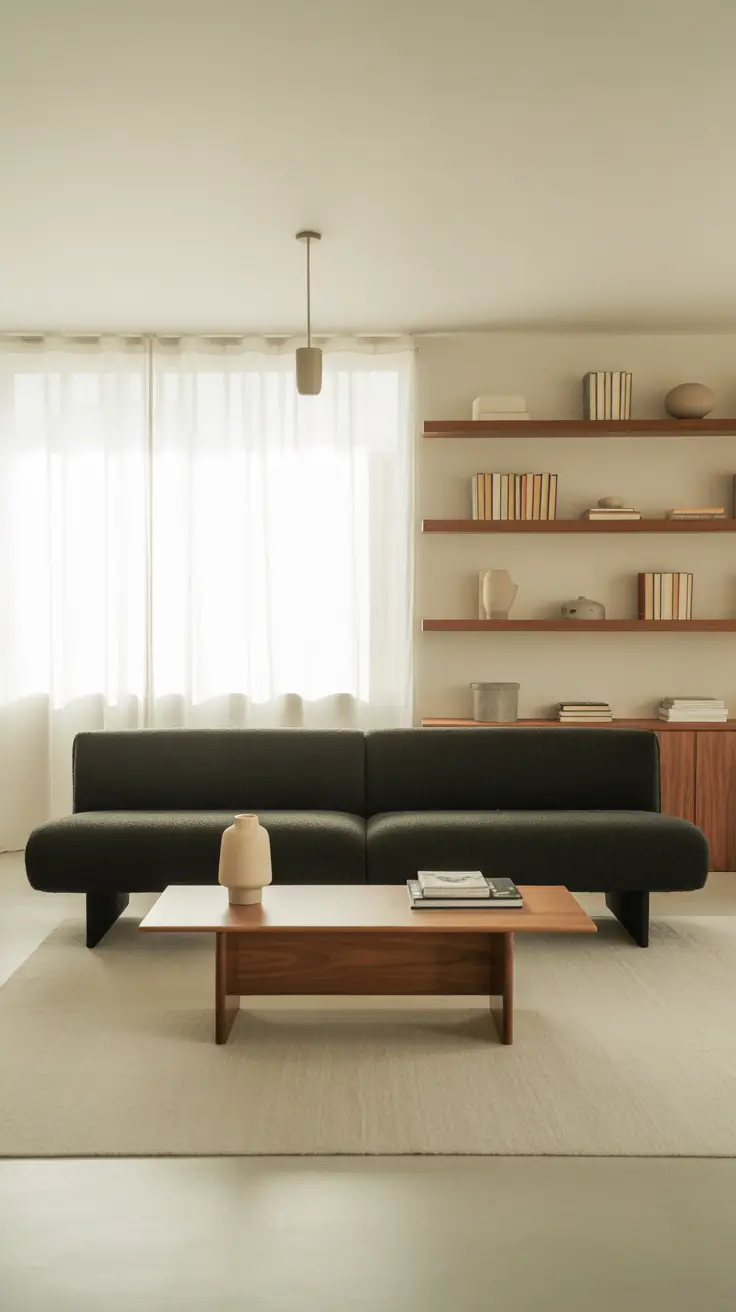
The furniture and design choices I incorporate include low-profile sofas, floating shelves, frameless artwork, and simple console tables. Each item is chosen for its purpose, aesthetic simplicity, and subtle impact on the room’s flow. I also integrate natural materials such as wood, linen, and stone to add gentle warmth while preserving the clean, airy feel. Soft, diffused lighting plays a crucial role as well, helping the room achieve a calm, balanced atmosphere.
In my experience, minimalist interiors are extremely rewarding for clients who want to reduce visual noise and maintain a clear space. Many design experts, including those from Dezeen, point out that restraint is often the key to successful minimalism. I’ve learned through practice that limiting decorative objects to only those with meaning or function maintains the integrity of the room without sacrificing personality.
To enhance this section, I would incorporate a note about organizing systems. Minimalism thrives when belongings have designated spaces, so well-planned storage is essential for sustaining the clean look long term.
Integrated Dining Spaces For Small Living Rooms
Combining a dining area with a compact living room can be highly effective, especially in tiny apartments, modern Indian apartments, and compact urban studios. I usually design integrated dining areas using space-saving strategies that ensure comfort without overwhelming the room. By visually merging the dining and living functions, I can help clients maintain flow while still enjoying a designated eating space.
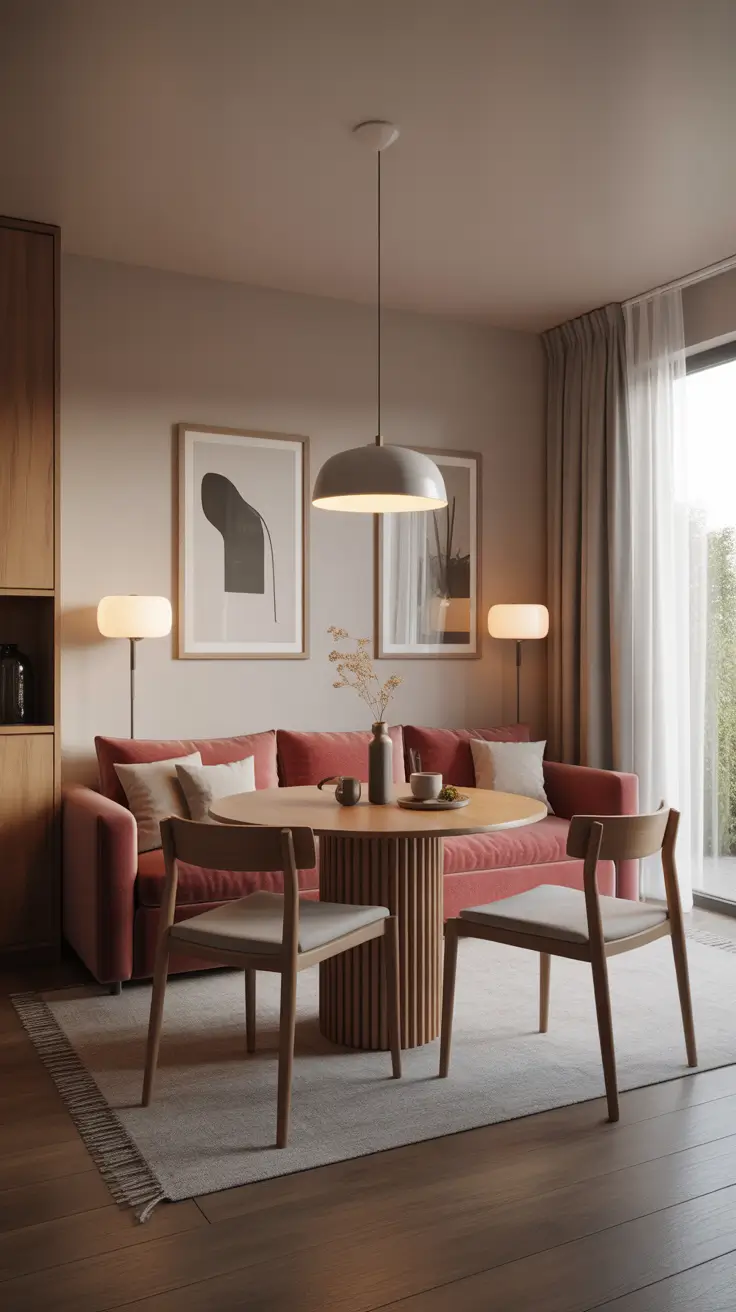
The furniture I prefer includes round compact dining tables, wall-mounted foldable tables, or narrow rectangular tables that align with the sofa. Paired with slim dining chairs or built-in benches, these pieces provide functionality without dominating the room. I also incorporate pendant lighting hung above the table to anchor the dining zone visually. This helps distinguish each function clearly while supporting a cohesive, uncluttered design.
Throughout my work, I’ve seen how successfully integrated dining areas can enhance small living rooms. They encourage more social interaction and allow residents to enjoy meals without sacrificing precious square footage. Many interior stylists featured in Homes & Gardens magazine highlight the efficiency of multifunctional dining solutions in small apartments, and I’ve personally found this guidance extremely useful in real projects.
To add more depth to this section, I would include advice on optimizing circulation around the dining area. Selecting chairs that tuck fully under the table and ensuring clear pathways prevents congestion, especially in very narrow rooms.
Creative Storage Ideas For Compact Apartments
Storage is one of the most important aspects of interior design in compact apartments, especially those in fast-growing cities like Mumbai. I typically begin by assessing vertical space, hidden nooks, and unused corners that can be transformed into functional storage zones. When storage is planned properly, the living room stays clean, organized, and visually spacious. This is essential for the everyday comfort of residents who live in tiny or micro studios.

The storage elements I prefer include built-in wall cabinetry, under-sofa drawers, floating shelves, and custom corner units. I also incorporate cleverly concealed storage within coffee tables, window benches, or TV units. These additions allow homeowners to store belongings without cluttering the room. Using light-toned materials and sleek handles ensures that the design remains modern and harmonious.
From my experience, storage design can completely change the way a small apartment functions. Many interior experts recommend integrating storage into architectural details, and I have consistently followed this advice. This approach not only saves space but also contributes to a more streamlined, elevated aesthetic. I’ve seen clients experience an immediate sense of relief once their storage is carefully optimized.
To strengthen this section, I would add an emphasis on customizing storage heights. Adjusting shelf spacing to accommodate specific items reduces wasted space and increases overall efficiency.
Modern Indian Aesthetics For Tight Urban Spaces
Modern Indian aesthetics have gained significant traction in compact urban homes, blending contemporary forms with cultural richness. When I design tight spaces influenced by modern Indian style, I focus on clean silhouettes, earthy colors, and handcrafted elements. These design principles allow small living rooms to feel warm, grounded, and reflective of India’s design heritage while remaining suitable for modern life.
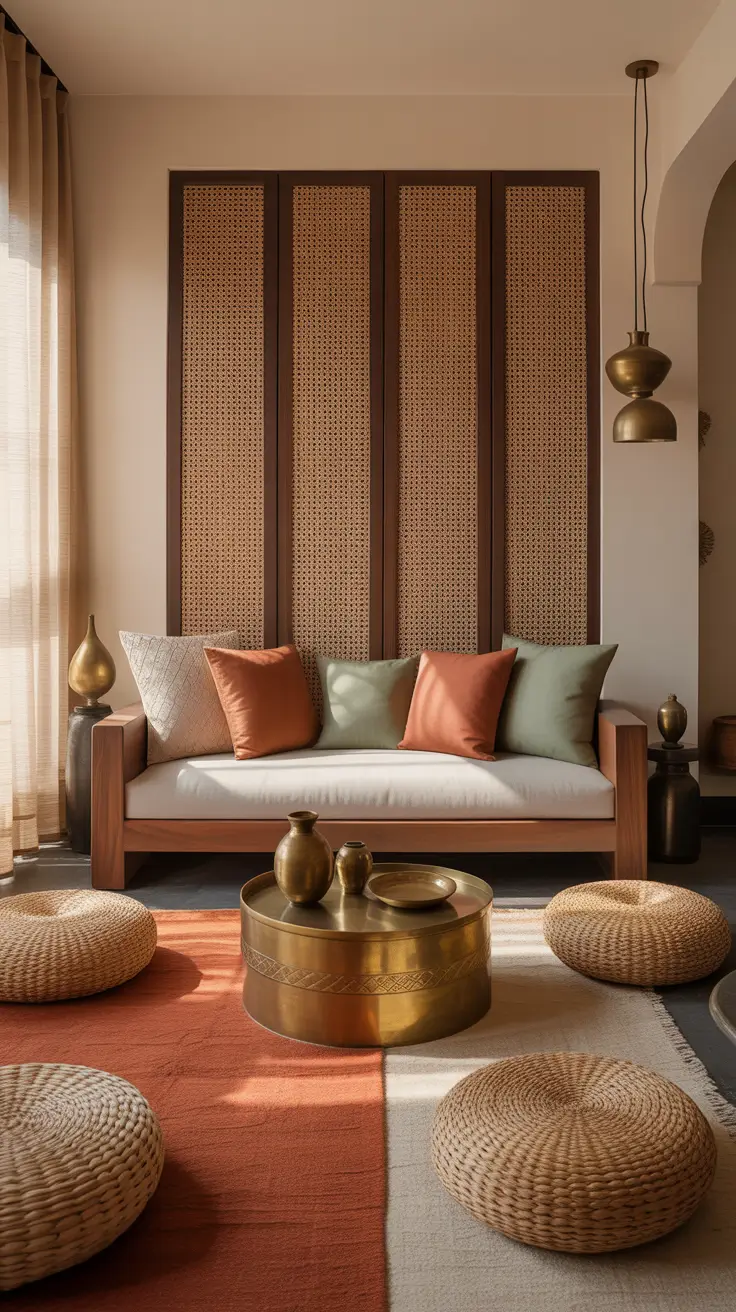
Furniture choices often include low wooden sofas, cane-paneled consoles, compact woven ottomans, and brass-accented side tables. I also rely on handcrafted décor elements like woven wall art, pottery, and textiles to add depth without overwhelming the room. Soft, warm lighting enhances the natural textures and creates a cozy, inviting atmosphere that aligns beautifully with modern Indian aesthetics.
My personal experience has shown that clients enjoy the balance between tradition and modernity that this style offers. Many Indian design professionals discuss the importance of blending heritage features with current trends, and I’ve applied this approach in numerous projects. It gives small rooms charisma while maintaining efficiency and clarity.
To complete this section, I would add suggestions on color palettes. Muted terracotta, warm beige, olive green, and dusty mustard tones complement the style beautifully and enhance the compact layout.
Open-Concept Plans To Expand Narrow Rooms
Open-concept layouts are one of the most effective methods for visually expanding narrow living rooms, especially in small houses, modern apartments, and tiny studios. When planning an open concept, I remove unnecessary visual barriers and allow the space to breathe. This strategy enhances natural light flow, improves movement, and creates a unified environment that feels larger and more welcoming.

For these spaces, I select furniture with streamlined profiles such as open-back sofas, narrow console tables, and floating entertainment units. These elements maintain clear sightlines from one end of the room to the other. I also incorporate rugs and subtle lighting differences to mark functional zones without constructing walls. This helps maintain openness while still supporting distinct daily activities.
From experience, homeowners often feel liberated when transitioning from closed-off layouts to open-concept plans. Many design experts agree that open layouts redefine how small apartments function, and this aligns with what I’ve observed in my own projects. The elimination of visual clutter creates a more harmonious experience, both aesthetically and practically.
To improve this section further, I would include recommendations on managing acoustics, as open spaces sometimes amplify noise. Soft textiles like rugs, curtains, and upholstered seating help maintain acoustic comfort.
Color Palettes That Visually Enlarge Small Spaces
When I design compact living rooms, I pay close attention to color because it dramatically changes how the size of a room is perceived. Soft neutral palettes are especially valuable in tiny apartments or small houses, as they reflect light and create an airy feel. I often use pale beige, warm ivory, soft gray, or muted sand tones for walls because they visually widen the space. This approach works exceptionally well in Mumbai and other dense cities in India, where modern interiors must feel light and open despite limited square footage.
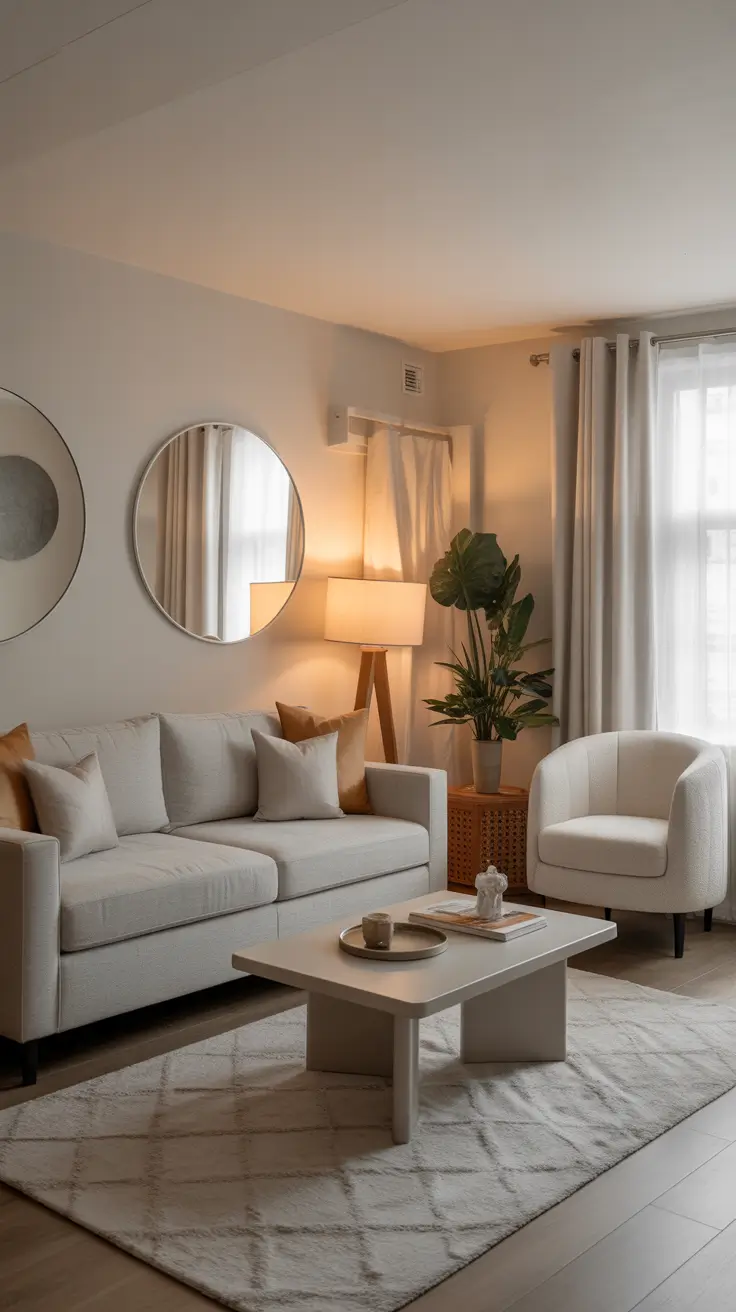
Each color used in a small room must serve a purpose. I prefer pairing light walls with deeper accent shades such as charcoal, olive, or walnut brown in the furniture, because this creates grounded contrast without visually shrinking the room. Low-profile sofas, wood-toned media units, and minimalist shelving in muted earthy tones help create a cohesive look that expands the overall feel of the space. Additionally, I often incorporate metallic finishes in decor pieces to subtly bounce light and add dimension.
In my experience, color psychology becomes even more important in compact homes. Over the years, I have followed advice from interiors professionals such as those at Real Simple, who frequently recommend soft transitional palettes for small spaces because they remove visual heaviness and promote calm. I’ve seen how clients respond positively to these palettes, saying their rooms suddenly feel larger, cleaner, and more inviting.
If I added anything more to this section, it would be a deeper explanation of how ceiling colors impact perceived height. A slightly lighter ceiling tone can instantly lift the room and open the spatial envelope even further.
Lighting Strategies To Brighten Tiny Living Areas
Lighting has a transformative impact in compact rooms, and I always prioritize layered lighting strategies when working on modern apartments, tiny studios, or small urban interiors. Natural light is my starting point, so I choose sheer curtains or light-filtering fabrics that soften sunlight without blocking it. In rooms that lack large windows, I rely on reflective surfaces to maximize brightness and enhance openness.

For artificial lighting, I typically incorporate three main layers: ambient, task, and accent lighting. Recessed ceiling lights and sleek pendant fixtures offer wide illumination without occupying visual space. Wall-mounted sconces and slim LED strips under shelves or cabinets contribute task lighting without clutter. Meanwhile, accent lighting such as table lamps or hidden backlighting behind media units creates ambiance that enhances depth. Together, these layers brighten the room and make it feel larger than it is.
Throughout my work, I’ve often turned to lighting principles shared by experts in Architectural Digest, who emphasize using multiple soft sources rather than one harsh overhead fixture. I’ve witnessed this method dramatically improve comfort and functionality in smaller rooms, especially where ceiling heights are modest.
To make this section even stronger, I would add tips on dimmers. Being able to adjust brightness levels helps the room adapt to different moods and functions, which is incredibly useful in compact multiuse spaces.
Modular Sofa Designs For Flexible Living
Modular sofas play a crucial role in compact living rooms because they allow homeowners to reconfigure their layout as needed. When I design for tiny apartments, micro studios, and compact Indian homes, I select sofa systems with detachable segments, movable ottomans, and hidden storage. Their flexibility supports changing lifestyles, especially in spaces that serve multiple purposes.
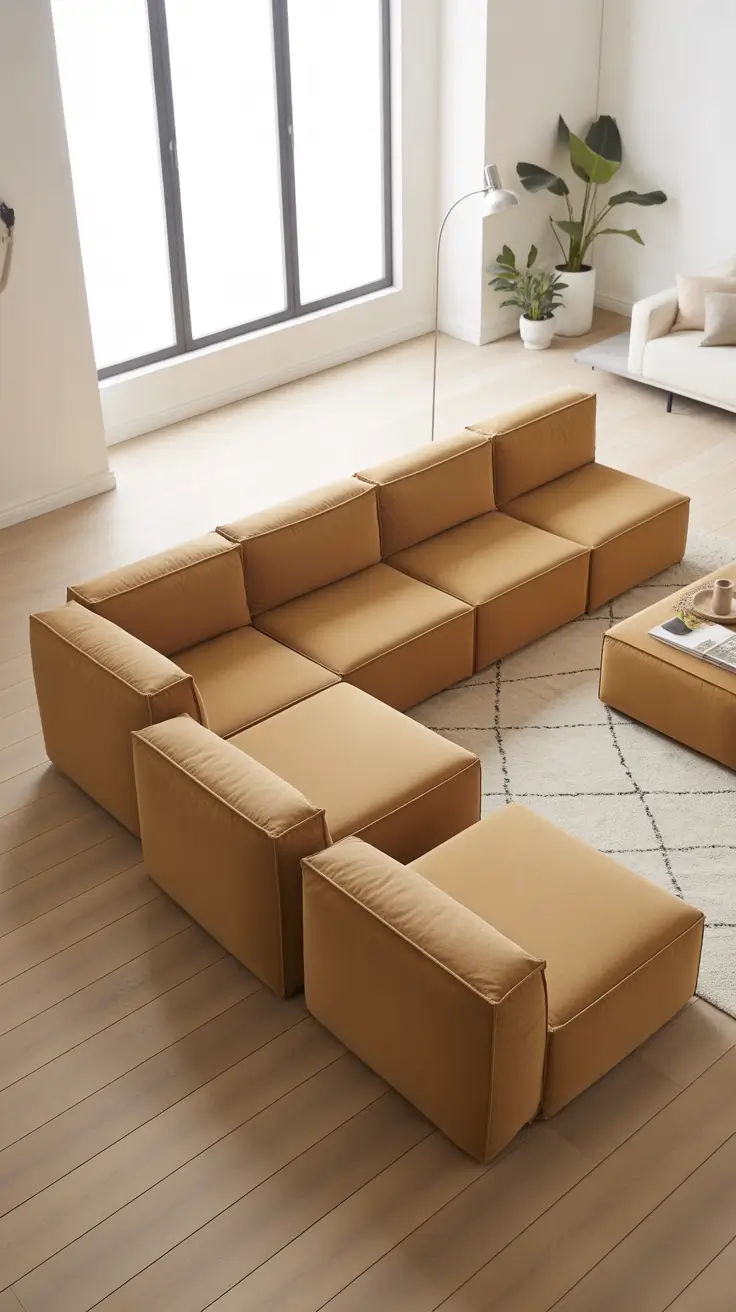
I prefer sofas with slim frames, raised legs, and neutral upholstery because these features visually lighten the room. Modular corner pieces, chaise units, and armless sections give homeowners the freedom to design their own layout. This flexibility is especially valuable in compact living rooms where the sofa must serve as both a seating area and sometimes a sleeping zone. Storage ottomans and movable side elements complement the design and ensure that every inch of the room is used efficiently.
In my experience, modular sofas often make clients feel more in control of their space. Many interior experts, including those featured in Dwell, highlight the growing relevance of modularity for urban living. I’ve seen these systems transform cramped areas into comfortable, dynamic rooms where residents can relax, work, and host guests.
If I expanded this section further, I would discuss fabric durability. Sofas in compact spaces receive more wear, so choosing durable performance fabrics ensures longevity and easy maintenance.
Vertical Styling Ideas For Apartment Interiors
Vertical styling is one of the most powerful techniques I use to make compact living rooms feel taller and more structured. By directing the eye upward, I create the illusion of height, which is especially useful in tiny studio apartments, small houses, and modern apartments across dense Indian metros. Tall shelving, elongated décor, and height-focused architectural lines contribute to a more open, elegant atmosphere.
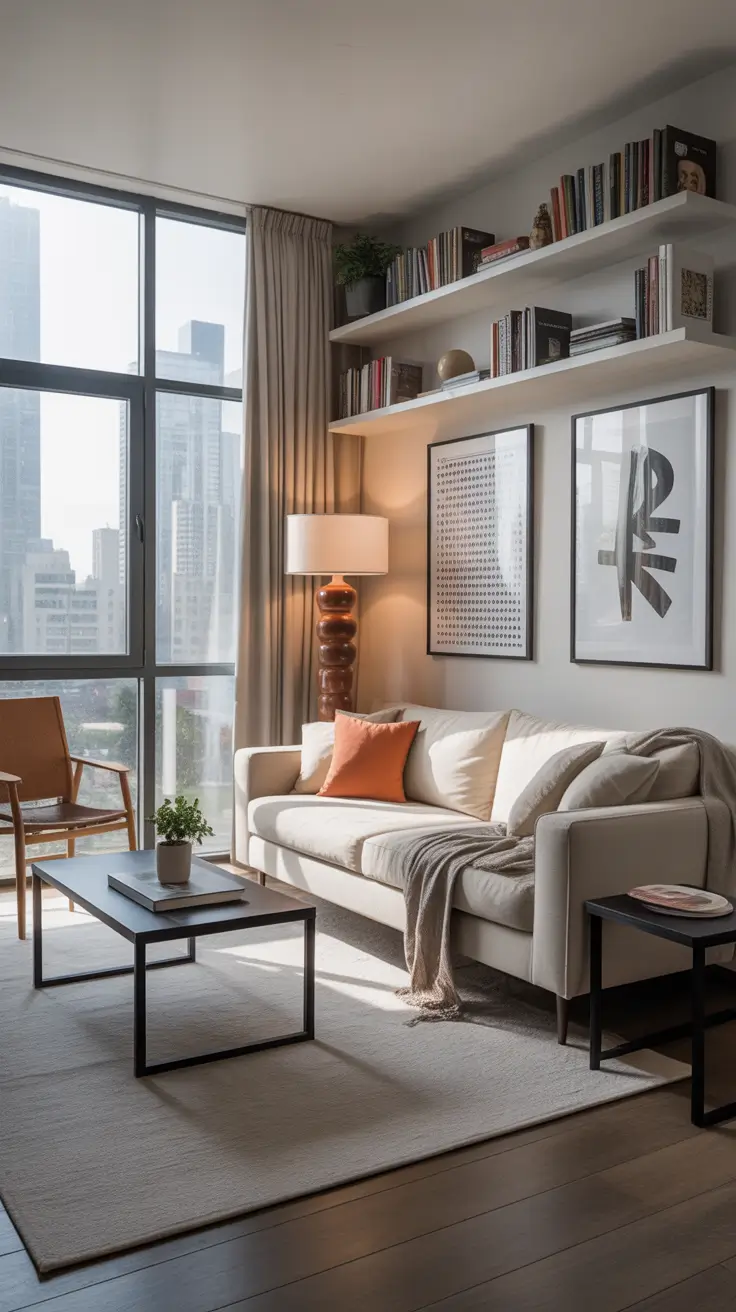
The key furniture pieces I choose include tall bookcases, vertical media towers, narrow storage columns, and wall-mounted floating shelves positioned closer to the ceiling. I also incorporate floor-to-ceiling curtains to visually elongate the walls and enhance the perception of vertical space. Artwork arranged in vertical clusters and pendant lights hung higher than typical also help elevate the eye.
I’ve used vertical styling in countless compact homes, and the results are consistently impressive. Design professionals often emphasize the importance of maximizing vertical real estate, something I’ve relied on heavily when working in cities like Mumbai, where floor space is limited but ceiling height varies. The right vertical balance brings sophistication, rhythm, and structure to a small living room.
If I added anything, it would be guidance on avoiding overcrowding. While vertical storage is useful, it must be curated thoughtfully to avoid making the walls feel too busy.
Smart Tech Enhancements For Compact Living Rooms
Smart technology has become essential in 2026, especially in compact living rooms where functionality must be maximized. I often incorporate discreet smart devices that enhance convenience without disrupting the room’s aesthetic. Residents in tiny apartments, modern Indian homes, and urban studios benefit greatly from smart features that streamline daily routines and help maintain order.
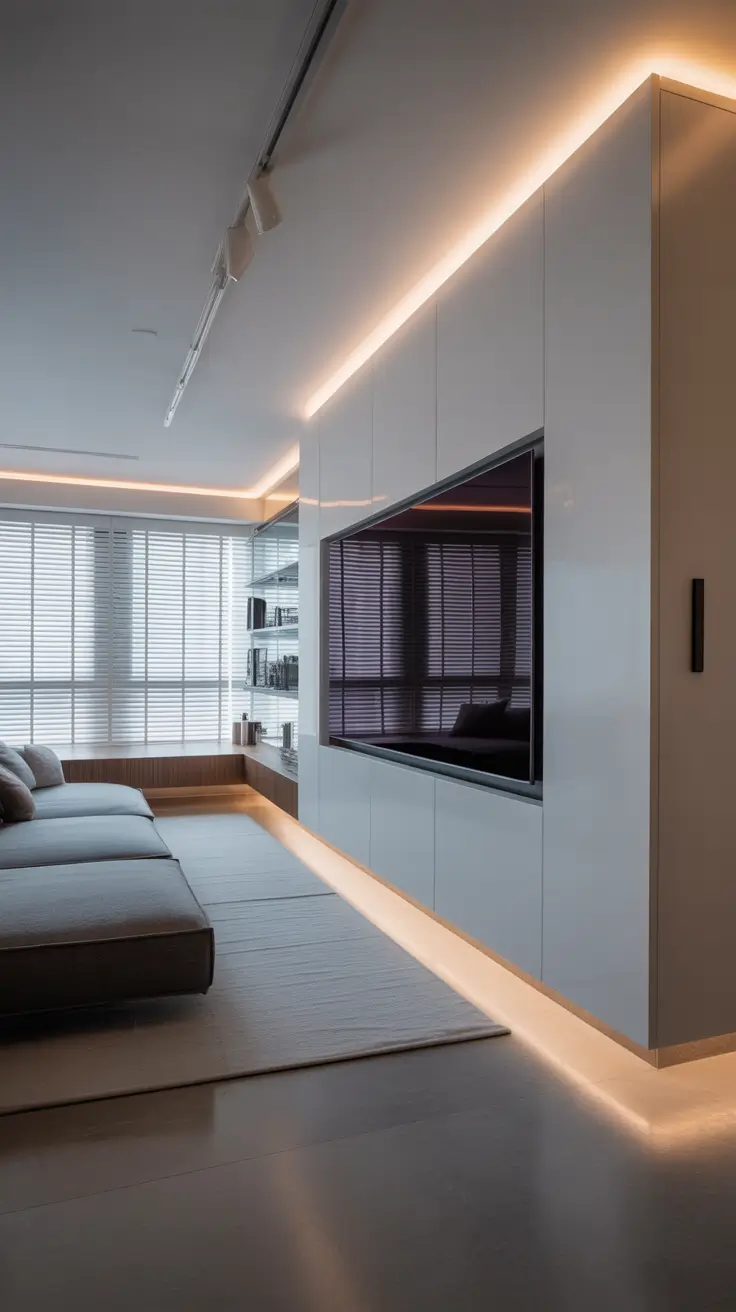
The tech elements I incorporate include voice-controlled lighting, concealed cable management systems, compact smart speakers, and ultra-thin televisions mounted flush to the wall. I also integrate motorized blinds, smart thermostats, and adaptive lighting systems that shift color temperature throughout the day. These additions optimize comfort and efficiency while preserving the minimalist look of a small interior.
In my experience, clients appreciate smart home upgrades because they reduce clutter and elevate the overall living experience. Tech-forward interior experts often recommend integrating devices seamlessly into the design rather than treating them as visible add-ons. I’ve found this advice extremely valuable, especially when performance and aesthetics need to coexist in tight layouts.
To enhance this section, I would include more detail about energy-efficient lighting and automation features that are particularly relevant in Indian households aiming to reduce power consumption.
Compact Dining Nooks For Urban Studio Living
When I design compact dining nooks in urban studio apartments, I focus on efficiency and comfort without overwhelming the living space. In dense cities such as Mumbai or other metropolitan areas in India, many residents rely on multiuse rooms, so the dining area must feel integrated without taking up unnecessary space. I usually incorporate small-scale furniture and streamlined shapes that allow the nook to blend seamlessly with the living room while still maintaining its own visual identity.

For furniture, I often select round pedestal tables because they reduce sharp visual corners and improve movement around the room. Slim upholstered chairs, narrow benches, or wall-mounted seats are excellent for minimizing bulk. I also incorporate overhead pendant lighting to define the dining zone without adding physical barriers. A shallow wall shelf nearby can display décor while doubling as functional storage for dining essentials. These scaled-down elements work well in tiny apartments, especially when paired with soft, warm colors that create intimacy.
In my experience, clients appreciate dining nooks that feel purposeful and cozy rather than forced into the layout. Many interior designers featured in Elle Decor suggest prioritizing scale and proportion when furnishing compact dining spaces, advice I apply regularly. When executed well, the nook contributes to a more harmonious and practical environment without visually shrinking the living area.
To expand this section further, I would include more details on walkway clearance. Ensuring enough space to pull out chairs and move around the table is essential for maintaining comfort in small studios.
Texture And Material Choices For Small Interiors
Texture plays a crucial role in shaping the character of compact interiors. When I design small living rooms, I focus on using balanced textures that add depth without overwhelming the space. Soft fabrics, natural materials, and refined finishes help achieve a layered look that feels intentional and cozy. This is especially important in tiny studio apartments and minimalist modern homes where visual clutter must remain low.
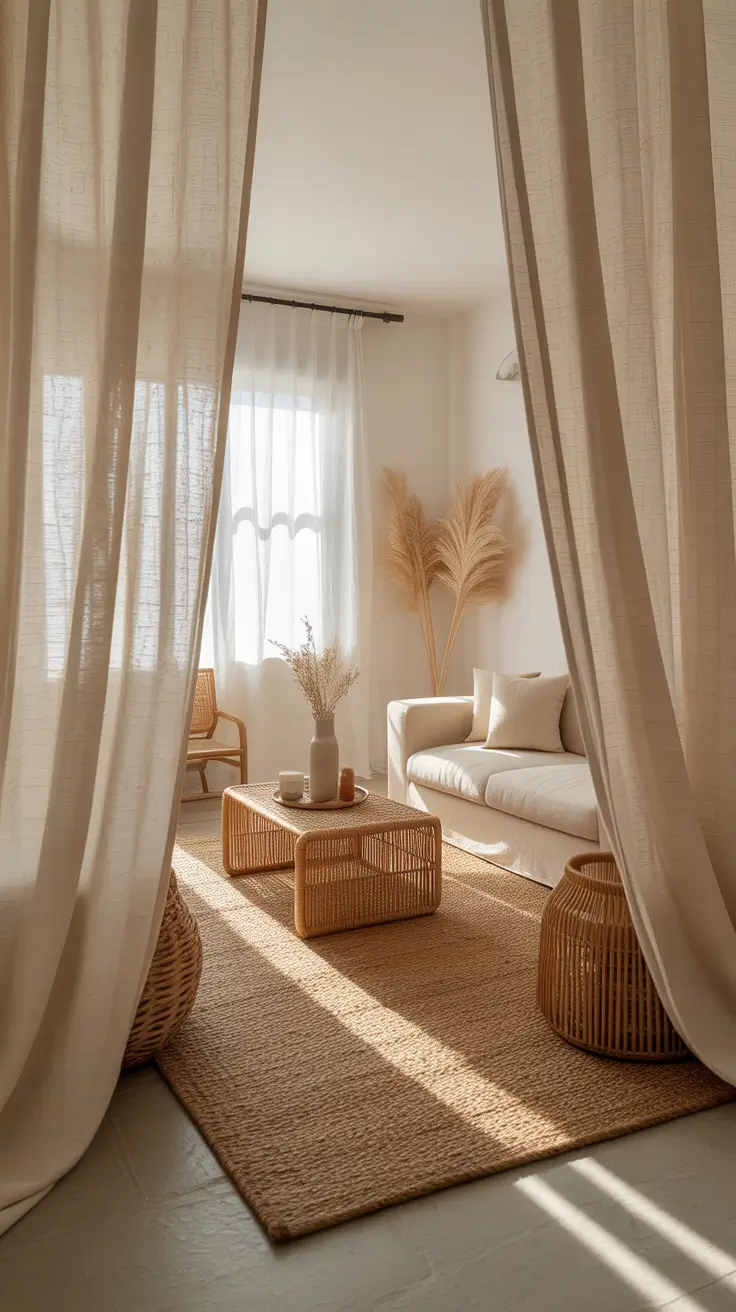
The materials I include vary according to the room’s style. Light linen curtains, soft upholstered sofas, smooth wooden tables, and subtle stone accents create a balanced mix of textures. I sometimes incorporate jute rugs, cane-front panels, or matte metal fixtures to bring warmth and tactile variation. The key is moderation: too many contrasting textures can make a compact living room feel chaotic, so I combine them thoughtfully.
From my experience, adding texture in layers creates a sense of luxury that small interiors often lack. Many professionals quoted in Homes & Gardens emphasize that texture is essential for preventing minimalist rooms from feeling too flat. I’ve seen how even a single textured accent, such as a woven ottoman or a patterned throw, can dramatically improve the room’s visual richness.
To strengthen this section, I would add guidance on choosing materials based on lighting. Reflective finishes work well in bright rooms, while matte textures can soften spaces that receive harsher sunlight.
Budget-Friendly Compact Living Room Makeovers
Budget-friendly makeovers require creativity, especially when dealing with small houses, tiny apartments, or compact modern interiors. When I work with a tight budget, I focus on high-impact updates that refresh the space without requiring major renovations. Paint, textiles, furniture repositioning, and affordable décor can dramatically transform the room while keeping costs low.
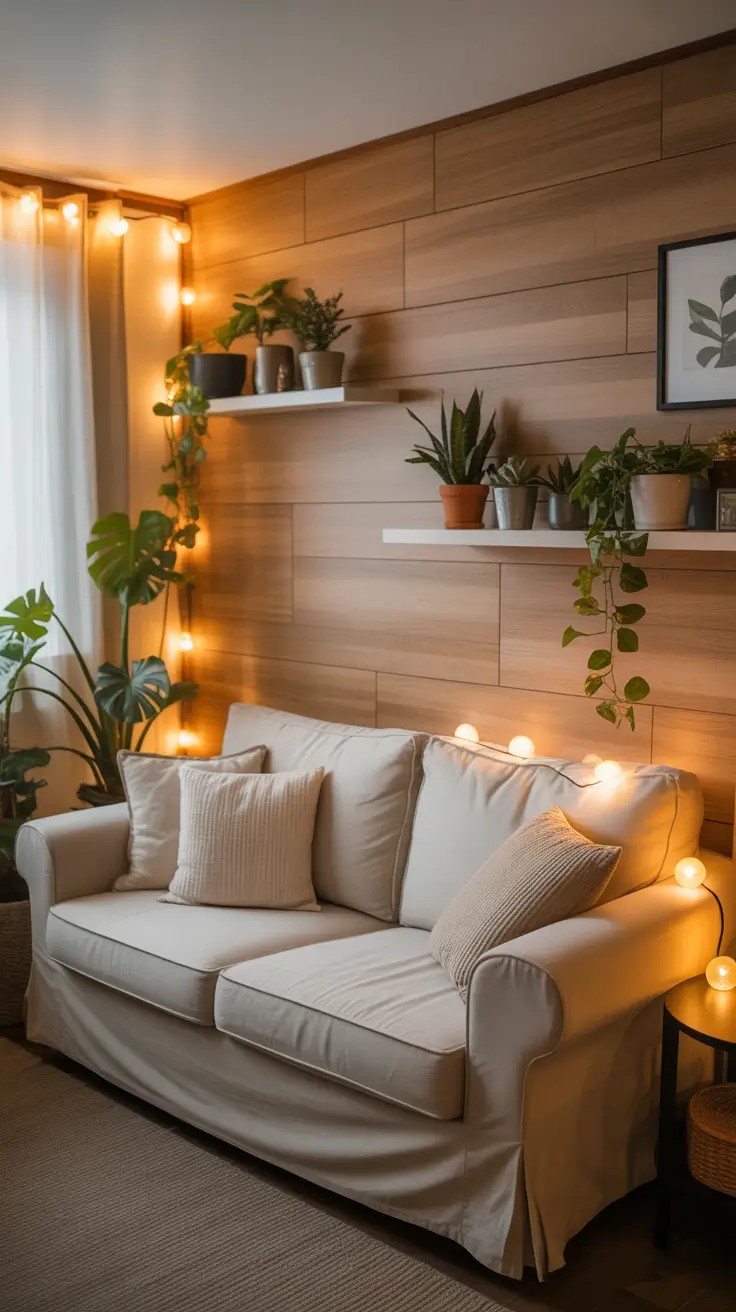
The pieces I use most often include slipcovers for sofas, peel-and-stick wall panels, versatile rugs, and low-cost shelving. Simple lighting upgrades, such as adding warm LED bulbs or replacing old fixtures with minimalist designs, also make a noticeable difference. Rearranging furniture to improve flow often costs nothing and still enhances overall comfort. Even adding plants in inexpensive pots can elevate the atmosphere and make small interiors feel more welcoming.
I’ve assisted many homeowners who feared they needed major investments to improve their compact living rooms. However, advice from experts at Apartment Therapy mirrors my own experience: small adjustments can create dramatic transformation. I’ve seen clients rediscover their space simply by refining décor choices and optimizing layout without purchasing large furniture pieces.
If I added more to this section, it would be tips on selecting second-hand or repurposed furniture. These options can be stylish, sustainable, and cost effective for small living room makeovers.
Sustainable Design Ideas For Micro Spaces In India
Sustainable design is becoming increasingly important across India, especially in dense urban areas where micro studio apartments and compact homes are common. When I focus on sustainability, I look for materials and practices that reduce waste, improve air quality, and promote long-term durability. This approach aligns perfectly with compact living because it emphasizes thoughtful consumption.

I often choose eco-friendly materials such as bamboo, reclaimed wood, natural jute, and organic cotton. Low-VOC paints and breathable natural textiles are essential for maintaining healthier indoor air. I also incorporate energy-efficient lighting and appliances to support long-term sustainability. Compact, multipurpose furniture helps reduce the need for excess pieces, which is especially valuable in tiny apartment interiors.
Many design experts in India encourage choosing quality pieces that last, rather than buying in excess. I’ve followed this guidance in my own projects and witnessed how eco-friendly materials create warm, grounded living rooms that feel both modern and responsible. Clients often appreciate how sustainability blends aesthetics with ethical living.
To add more depth here, I would mention the value of sourcing decor from local artisans. Not only does this support regional craftsmanship, but it also reduces the carbon footprint associated with mass-produced imports.
Statement Décor Pieces That Don’t Overwhelm Small Rooms
Designing compact living rooms doesn’t mean avoiding bold décor altogether. I often incorporate statement pieces strategically to elevate the room without overpowering it. A single standout element can add personality, especially in modern or minimalist spaces that rely on simplicity. When placed carefully, these pieces contribute visual interest without disrupting the room’s harmony.
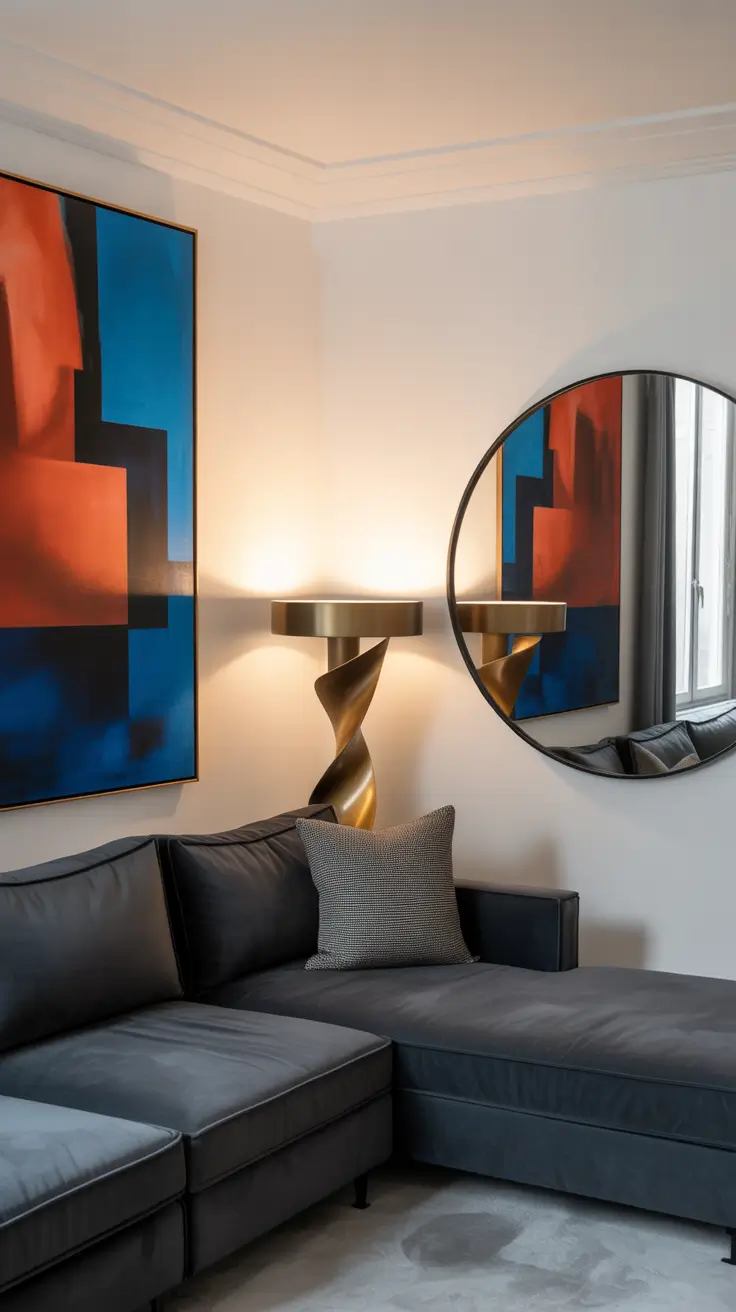
The statement pieces I typically recommend include a large framed artwork, a sculptural lamp, a uniquely shaped side table, or a bold-textured rug. The key is selecting one main focal element and keeping the surrounding pieces understated. This prevents the room from feeling busy while still showcasing personality. Even a dramatic plant or an oversized mirror works beautifully as a statement element in tiny apartments or compact interiors.
Throughout my professional experience, I’ve observed that clients feel more emotionally connected to rooms that include meaningful and memorable pieces. This approach aligns with advice from experts in Vogue Living, who emphasize that one strong decorative element often has more impact than many smaller accessories.
If I expanded this section, I would explain how to balance scale. Statement pieces must be proportionate to the room to avoid overwhelming the layout.
Future-Ready Living Room Ideas For India’s Urban Homes
As India moves toward 2026, compact urban homes are increasingly adopting future-ready design principles. When I design with the future in mind, I prioritize adaptability, multifunctional layouts, and smart home integration. Compact living rooms in cities like Mumbai benefit greatly from flexible environments that evolve with changing lifestyles.
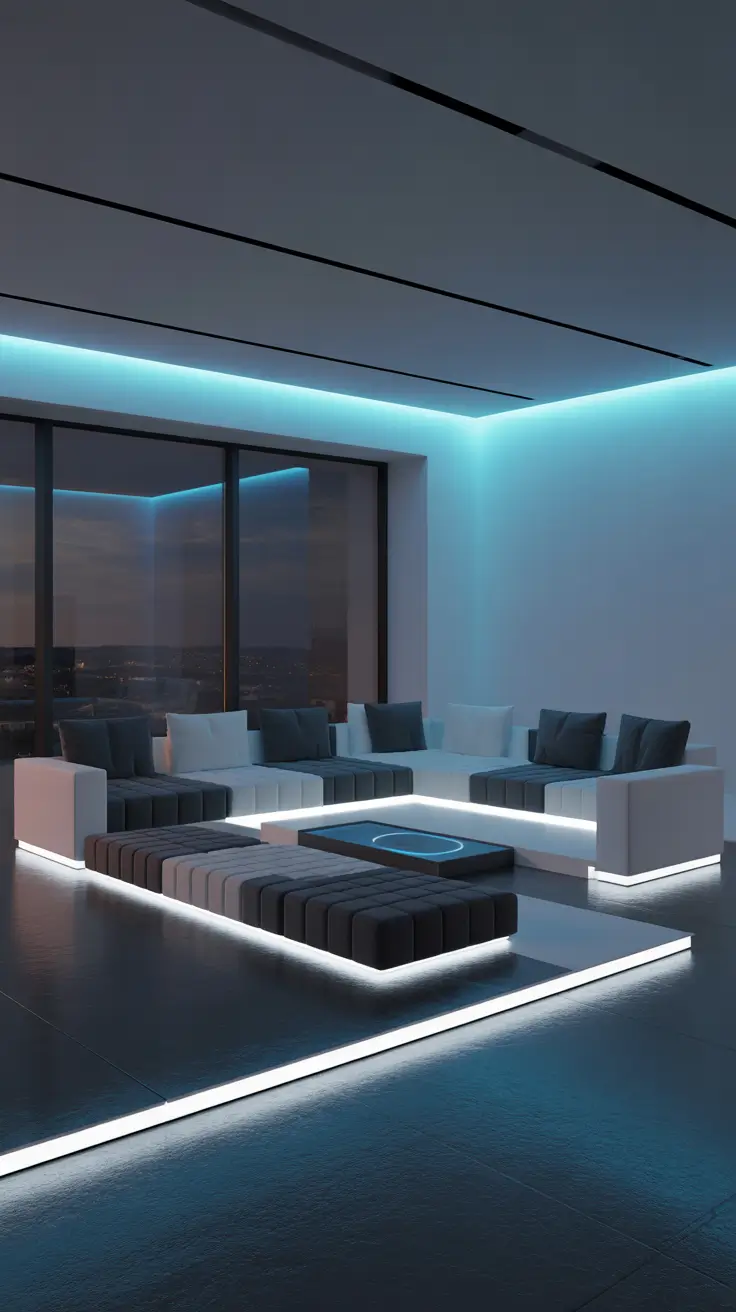
Key furniture pieces include modular sofa systems, expandable tables, lightweight chairs, and transformable shelving that adapts as storage needs grow. I also integrate tech-forward elements such as wireless charging tables, motion-sensitive lights, and space-efficient appliances. These additions help ensure that the room remains relevant even as lifestyles shift over time.
In my experience, homeowners appreciate future-ready designs because they offer long-term value. Industry professionals often recommend investing in adaptable furniture and tech enhancements for urban living. I’ve followed this advice closely and seen excellent results in compact interiors that remain functional for many years.
If I improved this section further, I would include tips on energy-efficient systems. Smart climate control and LED lighting significantly reduce long-term utility costs in small living rooms.
Creative Material Combinations For Modern Compact Homes
Material combinations shape the overall identity of a living room, especially in compact interiors where contrast must be handled with care. When designing for modern or Indian homes with limited space, I use material mixes that enhance texture without cluttering the visual field. Pairing smooth surfaces with natural textures creates a balanced, contemporary look.

My preferred combinations include matte wood paired with brushed metal, linen textiles combined with smooth stone, and woven accents placed alongside polished finishes. These mixes add depth and interest without overwhelming the room. I also incorporate glass elements, such as clear side tables or wall-mounted shelves, to reduce visual weight and maintain spaciousness. These combinations work beautifully in tiny apartments, small houses, and minimalist interiors.
Over time, I’ve found that clients enjoy rooms that feel tactile and dynamic, yet still cohesive. Many design studios, including those featured in Architectural Digest India, highlight material layering as a way to infuse personality into compact interiors. I’ve used this approach in many of my designs, and it consistently elevates the living room experience.
If I added more to this section, I would discuss finishes. Matte finishes create softness, while glossy elements introduce light reflection that can help brighten and visually expand the space.
Compact living in 2026 is not about limiting your lifestyle but about designing smarter. With the right color palettes, modular sofas, clever storage, and efficient zoning, even the smallest apartment can feel open, modern, and inviting. Whether you live in a tiny studio, a Mumbai apartment, or a minimalist home in India, these ideas prove that great design thrives in small spaces. Feel free to share your thoughts, ask questions, or leave a comment about which compact living solutions inspire you most.
